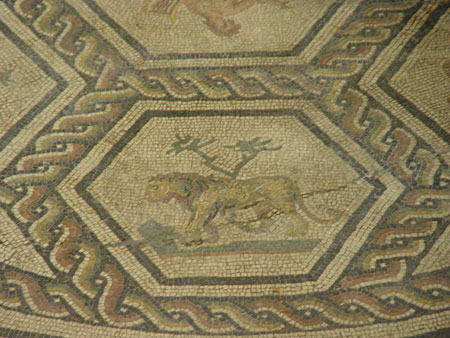ROMAN MOSAIC PAVEMENTS RIMINIHome > Monuments > Monuments Rimini > Roman Mosaic Pavements
MONUMENTS PROVINCE OF RIMINIMONUMENTS RIMINIThe Roman Mosaic Pavements in the City of RiminiBehind the Arch of Augustus and the Tiberian Bridge, noteworthy Roman monuments still visible, the mosaics found during archaeological excavations are the main and most fascinating examples of historical and artistic value of the Roman age in the city of Rimini. The mosaics, which paved in full large rooms, were composed of small square tesserae of stone or other materials, like stained glass, often with sides that measured only one centimeter, based on a stratum of lime. The mosaics were monochromatic, that is, made of tesserae of the same colour, usually black or white, or polychromatic, depicting various geometric patterns or images made up of tesserae of various colours. The use of the mosaic pavements in the city of Rimini spread from the Imperial age, that is, from the I cent. A.D., and grew significantly from the II up to the IV cent. A.D.. The mosaics found in the city of Rimini, although not particularly original in the decorative patterns, have been done by skilful artisans, who probably belonged to a good School of mosaic, operating in Rimini. The oldest mosaic pavements in Rimini were monochromatic: white or black. In some cases there were a frame and some marble tesserae in contrasting colours. Examples of this type of mosaic have been found, during archaeological excavations, in two rooms of the domus near the Arch of Augustus, in the domus in Diotallevi Palace and in the one in Minghetti Street. Black and white mosaics decorated with geometric patterns, as squares, rectangles, hexagons and, from the end of the I cent. A.D., octagons, which formed pavements of a great optical effect, spread in Rimini from the second half of the I cent. A.D. Among the others, the mosaic of the room D in the ex Bishopís Palace and the one found in the ex Galli Theater can be cited as examples of this typology. The most innovative trends of the times are shown in the domus excavated in the vaults of Diotallevi Palace. In that domus have been found black and white mosaics, innovated by the introduction of figurative motifs, like the beautiful depiction on the famous mosaic representing the harbour life, one of the Roman symbols of Rimini, and also a polychromatic mosaic pavement with geometric motifs. The polychromatic mosaics, in some cases with figurative motives, started to spread between the end of II and the first years of the III cent. A.D. The mosaic pavements discovered in the so called Surgeonís domus, in Ferrari Square, are conspicuous for their accuracy and beauty. The splendid polychromatic mosaic pavement depicting Orpheus has been found in the room A. This marvellous mosaic is based on a geometrical scheme of hexagons, in which are depicted satyrs and maenads, representing the Bacchic cortege, with crowns of greenery and musical instruments. In the centre there is the splendid emblema representing Orpheus encircled by wild animals, in the part of the mosaic on the threshold of the room there are two winged victoriae holding a tondo, in which a Gorgonís head is depicted. In room C, which probably was the triclinium of the domus, there was a mosaic pavement with a geometric decoration in the same colours of the mosaic representing Orpheus. Besides the splendid mosaic pavement representing Orpheus, there is also the noteworthy polychromatic mosaic found in Fratelli Bandiera Street, depicting a man with a dog head, probably the god Anubi, encircled by Egyptian animals, based on patterns from Africa and Near East, which were diffused through the so called cartoons.
|
